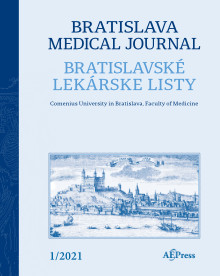Journal info
|
||||
Select Journal
Journals
Bratislava Medical Journal 2024 2023 2022 2021 2020 2019 2018 2017 2016 2015 2014 2013 2012 Ekologia - Ecology Endocrine Regulations General Physiology and Biophysics Neoplasma Acta Virologica Studia Psychologica Cardiology Letters Psychológia a patopsych. dieťaťa Kovove Materialy-Metallic Materials Slovenská hudba 2025Webshop Cart
Your Cart is currently empty.
Info: Your browser does not accept cookies. To put products into your cart and purchase them you need to enable cookies.
Bratislava Medical Journal Vol.119, No.2, p.98-102, 2018 |
||
| Title: Heart failure affects liver morphology and function. What are the clinical implications? | ||
| Author: E. Goncalvesova, M. Kovacova | ||
| Abstract: Liver dysfunction in heart failure is common and usually clinically significant, especially in patients with advanced or severe acute heart failure. Lesions are caused by an impaired hepatic circulation due to congestion and hypoperfusion. Congestive lesions are more common and typically manifested by painful hepatomegaly and increased direct bilirubin and alkaline phosphatase. The inferior vena cava and hepatic veins are usually dilated. Congestive lesions are characterized by dilatation of the central vein with fibrotic changes in the surrounding areas on histological examination. Isolated ischaemic lesions are rare and occur due to severe and prolonged ineffective perfusion, often accompanied by hypoxemia. Ineffective perfusion is reflected by an increase in total bilirubin and significantly increased transaminase levels. The prognosis of ischaemic lesions without an adequate treatment of the cause of hypoperfusion is poor. Increased levels of bilirubin and liver function tests, as well as signs of impaired liver proteosynthetic function, are associated with a poor prognosis. Knowledge of the phenotypes of hepatic lesions in heart failure is important to select the appropriate treatment for an acute decompensation. Changes in biochemical markers, hepatic perfusion or stiffness of the liver can be used to evaluate the effectiveness of diuretic treatment and achieve euvolemic status in the patients with heart failure (Tab. 1, Fig. 3, Ref. 28). |
||
| Keywords: liver dysfunction, heart failure, congestion | ||
| Published online: 12-Feb-2018 | ||
| Year: 2018, Volume: 119, Issue: 2 | Page From: 98, Page To: 102 | |
| doi:10.4149/BLL_2018_018 |
||
|
|
 download file download file |
|

